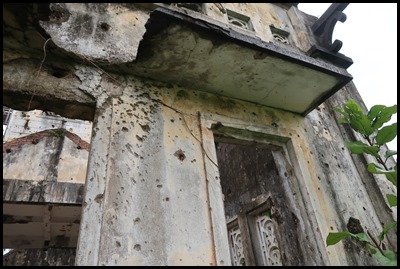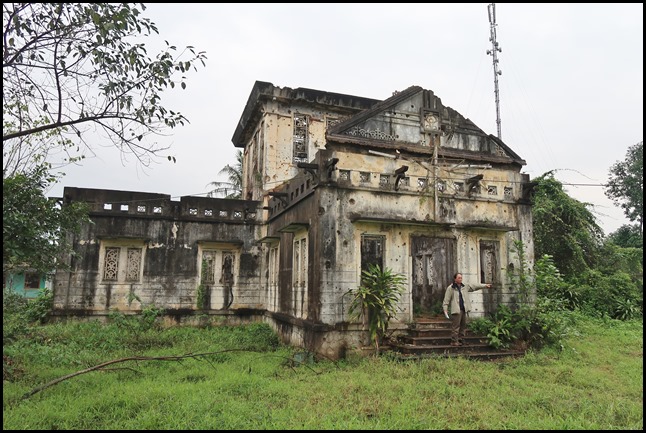Long Hung Church

|
Long Hung
Church
 Mr Trung, our guide, met us at our
digs and took us to meet our driver for the day. We set off at half past seven
and drove for about an hour to Long Hung Catholic
Church. Built in 1955, it was destroyed during the terrible Easter
battles of 1972. North Vietnamese forces took up position at the church during
the siege of Quang Tri, all that is left is the shell of the building and the
bell tower.
    The sign
outside reads: Long Hung Church (a component in relic complex of the
event of the 81 days and nights for protecting Quang Tri town to be ranked as a
national relic in 1986)
But in 1955 taking place
religious activities of Catholic people.
In 1972, the resilient fight of
our soldiers and people took place against the counter-attacks by American and
Southern Army to reoccupy Quang Tri town, Long Hung Church was one of important
positions to protect the town at this place, we fought against hundreds of
counter-attacks by the enemy and helped to protect Quang Tri old citadel for 81
days and nights of history.
Long Hung church a relic of the
war, this place is the memorial of the bravery of our soldiers and people.
Mmmm. Then we went inside.
      We began to look around, at first glance just a ruined church.
The battle for Quang Trị began on the 30th of March with preparatory artillery barrages on the key areas of the province. Meanwhile, infantry assaults supported by tanks overran outposts and firebases. The lightning speed of Communist attacks on those positions delivered shockwaves to the soldiers of the ARVN (Army of the Republic of Viet Nam), who were largely unprepared for the onslaught.
The first time since we arrived in Vietnam that we have actually seen bullet holes.
Bigger than bullet holes.
On the 1st of May General Giai decided that any further defence of the city was pointless and that the ARVN should withdraw to a defensive line along the My Chanh River. As the 3rd Division headquarters departed the city in an armoured convoy the U.S. advisors remained in the Quang Trị Citadel, however the command element finding Highway 1 blocked by refugees and PAVN (Peoples Army of Viet Nam) ambushes soon returned to the Citadel and requested helicopter evacuation. By late afternoon United States Air Force helicopters from the 37th Aerospace Rescue and Recovery Squadron and Army helicopters evacuated all remaining forces in the Citadel. By the 2nd of May all of Quang Trị Province had fallen to the PAVN and they were threatening Hue. The fall of Quang Trị gave North Vietnam its first major victory of the 1972 offensive. The North Vietnamese immediately imposed their authority in the province, as collective farms were set up and strict rules were forced on the villagers. Many victims and villagers who fell along with province under Communist control eventually fled. According to Gary D. Murfin, one of the lead writers to have done a survey on Vietnamese refugees after 1975, the province was an area of particularly dense Catholic concentration, many of whom were anti- communist. He estimated that 41% fled the area in fear of communist reprisals, 37% feared fighting, shelling, and bombing, and others fled because they were a family related to an ARVN soldier, or were at one point landowners. The Second Battle of Quang Tri began on my twelfth birthday (the 28th of June 1972) and lasted the 81 days (referenced on the sign above) until the 16th of September, when the ARNV defeated the PAVN at the ancient citadel of Quang Tri and recaptured most of Quang Trị Province. During the battle, the ARNV, backed by US military, expended more than 80,000 tons of ordnance.
Just sixty two years old and only in service for a short time.
We walked down the side of the church.........
........to get a view of the bell tower before continuing our DMZ tour with Mr Trung (pointing below), a veteran from the south. He was guarding Da Nang Airport toward the end of the war when he was captured and sent to a “re-education centre” (prison, by any other name..... that the inmates had to build themselves). We would learn that his uncle fought for the north, not a rarity that so many families were divided, families who lived and worked in the south and spied at night for the north and propaganda spoon-fed on a daily basis through loud speakers.  ALL IN ALL A STARK REMINDER OF
WAR
HARD TO BELIEVE IT WAS SUCH A PROTRACTED
BATTLE |










